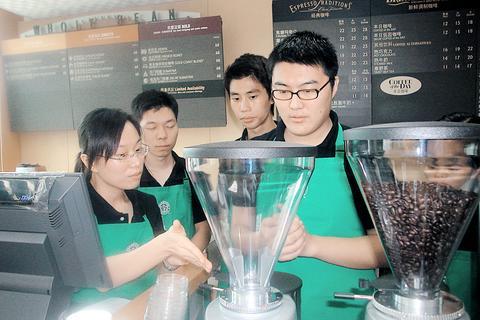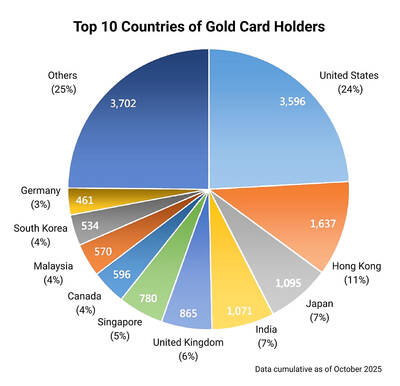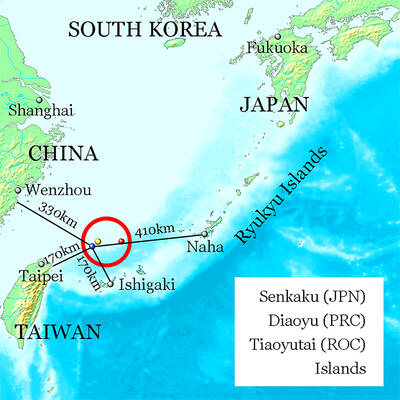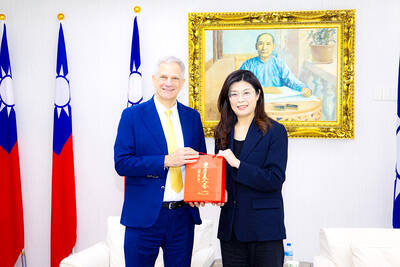Until a fortnight ago, former hotel worker Jeff Lin Hai Wah had never even tasted a cup of filtered coffee.
The 23-year-old will soon be serving up tall skinny lattes and other speciality coffee varieties to customers in his new job at the first branch of Starbucks in the sprawling city of Guangzhou in southern China.

PHOTO: DPA
"I'll be pretty nervous, especially serving coffee to expatriates and tourists who have been drinking coffee all their lives," he said. "When I grew up, we only ever had tea in the house. It wasn't until two or three years ago that I had my first cup of instant coffee."
Seattle-based Starbucks is one of three Western coffee chains opening or preparing to open shops in the sprawling city of Guangzhou, where for centuries tea has been the drink of choice.
There are more than 100 of branches of Starbucks in Hong Kong, Beijing and Shanghai, but now coffee shops are branching out for the first time into China's less cosmopolitan hinterland, with the southern center of Guangzhou their first target.
The main rival to Starbucks in Hong Kong, the Hong Kong-Singapore Pacific Coffee chain, is also seeking a partner to open its first Guangzhou branch.
Ironically, however, an outsider without a foothold in Hong Kong or the mainland has beaten them by opening Guangzhou's first western-style coffee house.
Canadian chain Blenz -- which has 29 outlets in British Columbia and four in Japan -- has just opened the doors on an outlet at the base of the high-rise Citic Plaza shopping and office block.
The outlet is already doing brisk business among office workers with prices ranging from 9 yuan (about US$1) for a fresh coffee to 28 yuan (US$3.40) for a grand cafe mocca -- while local cafes nearby charge as little as 1 yuan for a cup of green tea and 3 yuan for a set lunch.
The coffee shop chains believe the growing affluence in southern China's key city of Guangzhou will provide the potential to follow in the footsteps of Beijing, Shanghai and Hong Kong.
Ernest Luk, vice president of Starbucks Coffee Asia Pacific, said, "There will be other companies that will go into the China market and into Guangzhou but I see that competition as healthy.
"Guangzhou is, as China as a whole, a tea-drinking country. Coffee culture isn't very strong. By having multiple competition, we will see the market grow faster," Luk said.
"Looking at our customers in Shanghai and Beijing, the first people who come to us are the younger crowd -- younger professional workers who were maybe exposed to our brand when they were educated overseas."
Starbucks prices will be 10 to 15 percent lower in Guangzhou than in Hong Kong but still hugely more expensive than other corner cafes and tea shops around the city.
Angela Chou, marketing manager for Starbucks Hong Kong's joint venture Coffee Concepts, said she did not believe the relatively high prices would put customers off. "We see our product as an affordable luxury," she said.
Pacific Coffee's chief operating officer Rob Naylor agreed that Guangzhou was ready to embrace coffee shops, saying, "We would like to be there and we are actively looking and talking about it."
Naylor said he believed Guangzhou had enormous potential and said he expected to see a number of overseas chains move into the city in the months ahead.
"Once it gets going and people understand what coffee culture is, the market grows rapidly," he said. "It becomes part of peoples' lifestyle choices. Its not just about coffee. It is about the experience," he said.
"The Guangzhou market is developing so rapidly. Five years ago you could say it was 50 years behind Hong Kong. Now maybe its 25 years. Who knows where well be in another year's time?"
Meanwhile, the last-minute training continues for Guangzhou Starbucks recruits, with trainees watching a subtitled video in which a top Seattle executive extols trainees to put their passion into making the perfect expresso, telling them, "You are an artist."
Karen Cheung Po Shan, 28, who was sent from Hong Kong to train the Guangzhou staff, said employees took little time getting a taste for drinking coffee, even after a lifetime of drinking tea.
Their expression when they first try it is funny to watch, she said. At first they complain it is too strong, but they gradually get used to it. Karen and her bosses at Starbucks are banking on the hope that the tea drinkers of Guangzhou will react in much the same way.

Seven hundred job applications. One interview. Marco Mascaro arrived in Taiwan last year with a PhD in engineering physics and years of experience at a European research center. He thought his Gold Card would guarantee him a foothold in Taiwan’s job market. “It’s marketed as if Taiwan really needs you,” the 33-year-old Italian says. “The reality is that companies here don’t really need us.” The Employment Gold Card was designed to fix Taiwan’s labor shortage by offering foreign professionals a combined resident visa and open work permit valid for three years. But for many, like Mascaro, the welcome mat ends at the door. A

Last week gave us the droll little comedy of People’s Republic of China’s (PRC) consul general in Osaka posting a threat on X in response to Japanese Prime Minister Sanae Takaichi saying to the Diet that a Chinese attack on Taiwan may be an “existential threat” to Japan. That would allow Japanese Self Defence Forces to respond militarily. The PRC representative then said that if a “filthy neck sticks itself in uninvited, we will cut it off without a moment’s hesitation. Are you prepared for that?” This was widely, and probably deliberately, construed as a threat to behead Takaichi, though it

If China attacks, will Taiwanese be willing to fight? Analysts of certain types obsess over questions like this, especially military analysts and those with an ax to grind as to whether Taiwan is worth defending, or should be cut loose to appease Beijing. Fellow columnist Michael Turton in “Notes from Central Taiwan: Willing to fight for the homeland” (Nov. 6, page 12) provides a superb analysis of this topic, how it is used and manipulated to political ends and what the underlying data shows. The problem is that most analysis is centered around polling data, which as Turton observes, “many of these

Since Cheng Li-wun (鄭麗文) was elected Chinese Nationalist Party (KMT) chair on Oct. 18, she has become a polarizing figure. Her supporters see her as a firebrand critic of the ruling Democratic Progressive Party (DPP), while others, including some in her own party, have charged that she is Chinese President Xi Jinping’s (習近平) preferred candidate and that her election was possibly supported by the Chinese Communist Party’s (CPP) unit for political warfare and international influence, the “united front.” Indeed, Xi quickly congratulated Cheng upon her election. The 55-year-old former lawmaker and ex-talk show host, who was sworn in on Nov.